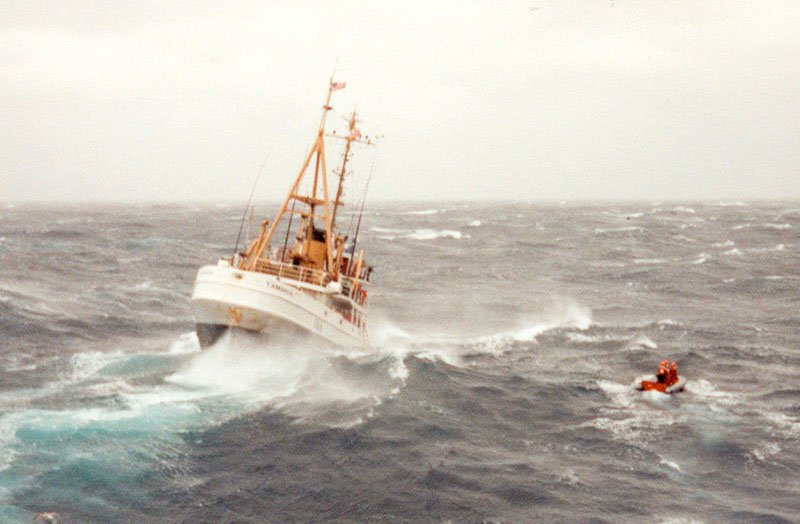The Tamaroa, a World War II Navy fleet tug turned Coast Guard cutter, famed for rescues from Iwo Jima to New England, could not be rescued from old age.
The Tamaroa in heavy seas during the Halloween storm of 1991. USCG photo.A 10-year restoration effort ran out of money and time, and soon the cutter is to be sunk on an artificial fishing reef site close to New Jersey and Delaware. The Tamaroa was already one of the oldest ships in the Coast Guard when its crew rescued sailors and the crew of a downed helicopter in the so-called “Perfect Storm” of October 1991.
The 205’x39’x18’ vessel, commissioned as the USS Zuni in 1943 and acquired by the Coast Guard in 1946, has a storied history, from service in the Pacific war to numerous search and rescue operations in the Northeast, including the sinking of the ocean liner Andrea Doria in 1956.
But the Tamaroa’s fame in both Coast Guard lore and popular culture was born of the 1991 Halloween storm, a giant hybrid system with effects from the mid-Atlantic U.S. coast to the Grand Banks.
On Oct. 26, the Coast Guard First District command center received a distress call relayed by a freighter from the Satori, a 32’ sailing yacht with three persons on board en route from Portsmouth, N.H. to Bermuda.
Nearly 50 years old at the time, the Tamaroa plowed through mounting seas as Coast Guard aircraft circled the sailboat. The single-screw cutter was powered by four General Motors 12-278 diesels, turning Allis Chalmers generators for four electric motors with a total 3,010 hp. The Tamaroa’s 18’ draft and 10’ freeboard helped handle seas building past 30’.
At the scene, the cutter’s captain Cmdr. Larry Brudnicki tried to evacuate the Satori crew, but the sea conditions were too much for his ship’s rigid hull inflatable boat. A helicopter lowered its rescue swimmer to pick up the sailors, and flew them to Cape Cod.
Meanwhile, a New York Air National Guard HH-60 helicopter on another rescue mission for the doomed longline fishing vessel Andrea Gail had been unable to make a mid-air refueling, and ditched 90 miles south of Montauk, N.Y. Coast Guard air crews located the fliers, but winds up to 100 mph made a helicopter hoist impossible.
After a four-hour steam the Tamaroa arrived, and began a two-hour struggle to retrieve the airmen, as the cutter rolled through 110 degrees with wave tops over the ship. Coast Guard historian William H. Thiesen described the scene:
“Green water regularly swept Tam’s deck, swamping her deck crew. Meanwhile, the engineering crew worked feverishly to keep the 50-year-old powerplant running; a breakdown during this critical point, especially with only one screw, would prove disastrous. With the National Guard aircrew fighting for their lives in the roiling water, Brudnicki tried several times to position the cutter upsea of the men and drift down on them for the rescue.
“After two hours, Tamaroa succeeded in maneuvering next to the hypothermic aircrew while the deck gang dropped a scramble net over the cutter’s side. By pulling the net up in sync with the cutter’s severe roll, the Tam’s crew retrieved one airman and then pulled up a group of three others. The downed H-60’s pararescueman, Rick Smith, was never found despite a massive search effort later mounted to locate him.”
The Tamaroa rescue would become a key scene in “The Perfect Storm,” Sebastian Junger’s bestselling book about the loss of the Andrea Gail, and the 2000 movie of the same name. In the screen version, filmmakers portrayed the Tamaroa as a modern ship, sleek as an Aegis missile destroyer.
The real Tamaroa was showing its age soon after the rescue. Faced with a potential $1 million overhaul, the Coast Guard decided to retire the vessel. It was acquired by the nonprofit Zuni Maritime Foundation, which began a decade-long effort to restore the vessel to its World War II Navy condition.
But costs mounted beyond the group’s fundraising. In May 2012, while awaiting a drydocking in Norfolk, Va., the vessel began leaking, flooding the engine room and leading to the discovery of more leaks in the corroded hull.
Rather than scrapping, the Tamaroa was held for use in New Jersey and Delaware’s shared artificial reef – a fate that allows old vessels to live on in a sense, as fish havens and destinations for fishing and recreational diving. Delaware is taking the lead on the Tamaroa deployment, but there's no date set as yet for the sinking, said Joanna Wilson, a spokeswoman for the state Department of Natural Resources and Environmental Control.
New Jersey stepped up its reef additions this year, after a five-year pause over disputes between recreational and commercial fishermen using the reefs. The U.S. Fish and Wildlife Service weighed in by withholding federal grant money, raised by excise taxes on recreational fishing gear and boat fuel, after hearing complaints that commercial trap gear impeded anglers’ access to reefs.
A long-sought compromise this year allows commercial use on portions of two reefs in New Jersey state waters, and renewed reef building. That freed up $119,250 in federal funding to help with towing and other costs of sinking old vessels.
A version of this story originally appeared on our sister site, WorkBoat.com.







